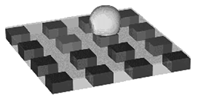SIAM Conference on CS&E: The Computational Challenges of Microsystem Simulation
May 30, 2003

Figure 1. Elevation view of the Programmable Fluid Processor.
Tom Korsmeyer and Jun Zeng
Microsystems are found in a wide variety of applications: sensors, such as accelerometers that fire airbags; RF components, such as resonators and switches; optical network components, such as cross-connects; and labs-on-chip, such as DNA sequencers and chem/bio detectors. These systems are fabricated by deposit-and-etch, micromachining, or molding, from such materials as silicon, metals, glass, and plastics.
For microsystems, two main challenges of computational prototyping drive algorithm choice and design: the multiplicity of physical domains encountered and the computational cost of the analyses even when the physical domains are not coupled. The multiplicity of physical domains arises from the fact that these are indeed systems, with moving parts, fluid flow, gas damping, electronic circuits, and so forth. The cost arises from the fact that the fabrication techniques allow designers to use significant geometric features that are one or more orders of magnitude smaller than the overall device dimensions.
For many designs, the computational cost can be addressed by the use of system-level simulation, as in the familiar circuit simulation paradigm of Electronic Design Automation. This level of abstraction, however, is useful only when an extensive library of components is available to populate the system representation. Mathematically, system-level simulation amounts to a replacement of PDEs by very low-order ODEs, and inherently couples different physical domains. When such abstraction is either not possible or not desirable, (possibly coupled) PDEs or integral equations must be solved, and the use of fast algorithms, such as the precorrected-FFT accelerated boundary-element method, becomes a necessity.
The issue of multiple physical domains makes severe demands on simulation software in terms of the number of computational modules that must be present, and in terms of the algorithms needed for efficient, stable, coupled simulations. Consider the Programmable Fluid Processor (PFP) shown in Figure 1. This is a lab-on-chip under development at the M.D. Anderson Cancer Center that will have applications in disease screening and battlefield contaminant detection. In the PFP, analytes and reagents are drawn from reservoirs as aqueous droplets and suspended in an insulating liquid. The droplets are moved by electrostatic force, so that they mix and react with each other in the pre-programmed sequences of an analysis.
The computational prototyping of an analysis in the PFP requires the simulation of the fluid filling of spaces, immiscible fluid droplet motion under electro-hydrodynamic forcing (dielectro-phoresis (DEP) and electro-wetting (EWOD)), chemical reactions coupled with fluid mixing, and an optical system for the detection of reaction products via fluorescence.
As is sometimes the case in the design of new microsystems, too little was known about the physical processes determining PFP behavior for the design to begin at the system level. For instance, at the outset of the design process for this device, the complete nature of the electrostatic force on a droplet was poorly understood. Only after systematic computational electro-hydrodynamic studies did it become clear that the electrostatic force is composed of three effects, as indicated in Figure 2. And even now, the "tea effect" is not fully characterized. Experimenters working with a physical PFP prototype noticed that droplets forced to jump sequentially from electrode to electrode, with little pause, require a certain voltage to initiate each motion. An experimenter who returns to the device after a cup of tea, however, finds that a much greater voltage is required to initiate the first jump of a sequence. The leading theory explaining this behavior is that there is charge contamination of the aqueous droplets; further simulation is planned to confirm or refute this view.

Figure 2. Three contributions to the electrostatic force: DEP in the volume and droplet surface, EWOD at the triphase (droplet, insulating liquid, hydrophobic surface) contact trace.

Figure 3. Visualization of electric potential from a transient electro-hydrodynamic simulation of droplet motion. (The insulating fluid and the hydrophobic layer are removed for clarity.)
After many series of simulations of the physics of the PFP, it is now possible to construct some of the library components that would make the system-level simulation of such devices possible, greatly reducing costs for future designs.
Acknowedgment
The PFP research is supported by DARPA contract DAAD10-00-1-0515 from the Army Research Office to the University of Texas M.D. Anderson Cancer Center, Principal Investigator: Dr. Peter Gascoyne.
Tom Korsmeyer and Jun Zeng are scientific software developers at Coventor, Inc.

